It’s easier than you might think to make delicious, fresh homemade pasta with just a handful of simple ingredients whether you are craving fettuccine, spaghetti, lasagna, rigatoni, or something else. The tender noodles cook to al dente perfection in just minutes and are perfect with your favorite sauces!
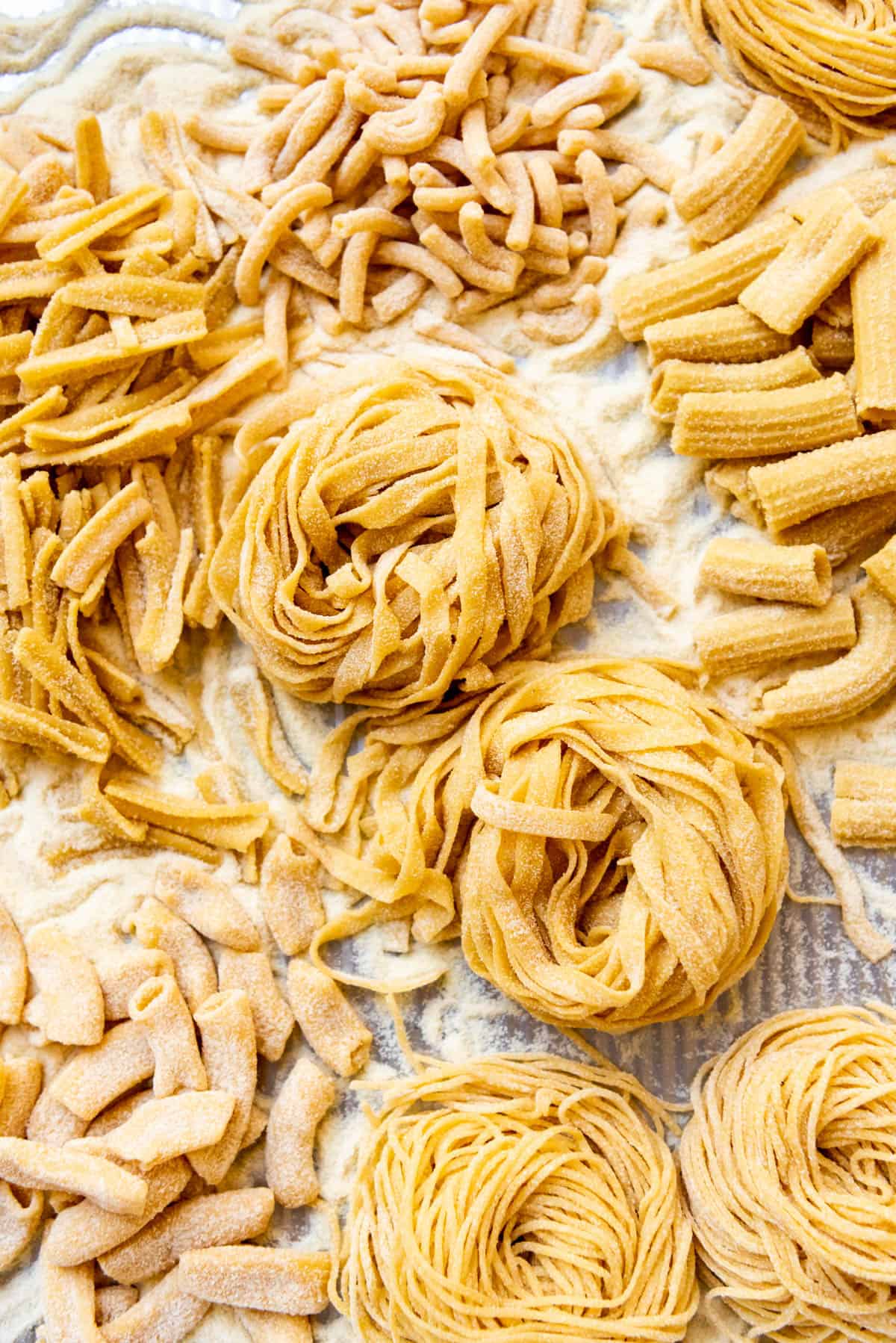
Table of Contents
- Why You Should Make Fresh Pasta
- What You’ll Need
- How to Make Homemade Pasta Dough
- Spinach Pasta
- How to Make Fresh Ribbon Pasta
- How to Make Shaped Pasta
- How to Make Pasta Without a Machine
- How to Make Pasta With a Machine
- How to Store Homemade Pasta
- How to Cook Homemade Pasta
- Recipe FAQ’s
- Tips for Success
- How to Store Fresh Pasta
- Our Favorite Pasta Recipes to Use With Homemade Pasta
- Homemade Pasta Recipe Recipe
I love fresh pasta. It cooks so quickly and tastes incredible, but I put off learning to make it for a long time because I was intimidated by the process. I can’t tell you how many times I have paid an exorbitant amount for a small package of fresh pasta at the farmer’s market!
But it’s actually really simple to make fresh pasta from scratch at home with this easy homemade pasta recipe!
The best part is that you can prep your fresh pasta up to 24 hours in advance (or even freeze it for longer storage!) and have it ready to go for your next dinner party.
I’m sharing my best fresh pasta recipe with step-by-step instructions and all my tips and tricks to make your own fresh pasta your very first time!
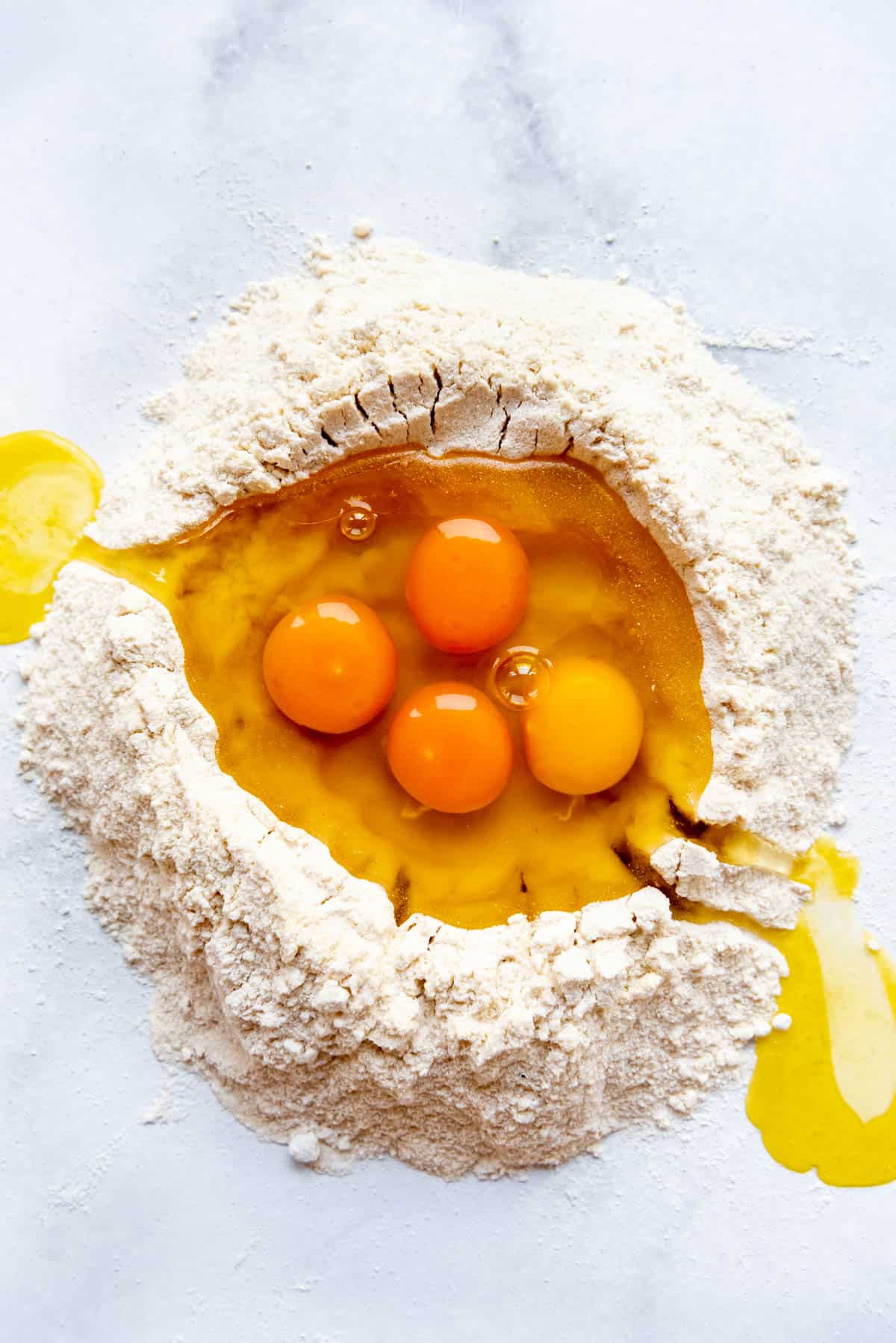
Why You Should Make Fresh Pasta
- Taste. Yes, you can taste a difference between fresh pasta made with semolina flour and the inexpensive dried pasta from the grocery store.
- It’s fun! There is something about the hands-on feeling of mixing the pasta dough, kneading it by hand, and running the dough through the pasta maker that is therapeutic and relaxing.
- Impress literally everybody. It’s true – people go crazy over fresh pasta and will think you are amazing for doing it when you really know it’s actually not difficult at all!
Using this one recipe, you will be able to make fresh pasta for:
- Fettuccine, linguine, pappardelle
- Fresh lasagna sheets
- Spaghetti noodles
- Rotini, rigatoni, macaroni
- Homemade ravioli
Whether you are making long ribbon pasta like fettuccine (my personal favorite) or shaped pasta (awesome for all kinds of sauces), you’ll be set with the recipe and techniques explained in this post!

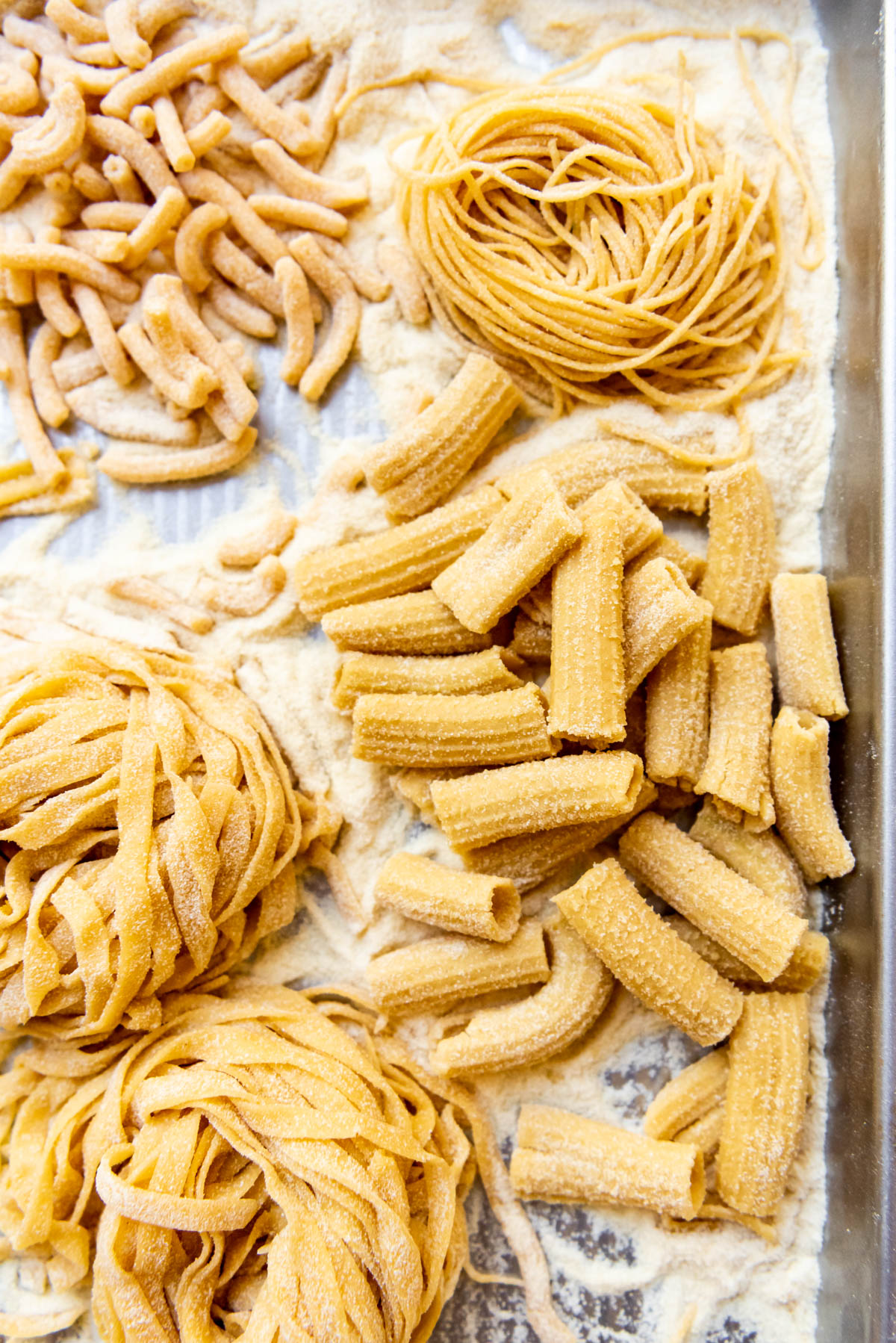
What You’ll Need
This is the best homemade pasta recipe and it only takes 5 ingredients, unless you are making flavored pasta like spinach pasta, cracked pepper pasta, or beet pasta.
Scroll down to the recipe card below this post for ingredient quantities and full instructions.
- Flour – I like to use half semolina flour and half all-purpose flour. But you could use all of one or the other, or use 00 flour or whole wheat flour instead.
- Eggs – You’ll need four large eggs.
- Water – Just enough to make a nice workable dough.
- Olive oil – I like to add just a little olive oil to my dough for flavor and to make it easier to work with.
- Salt – Pasta should be cooked in salted, boiling water, but we add a little salt to our pasta dough to make sure it isn’t bland.
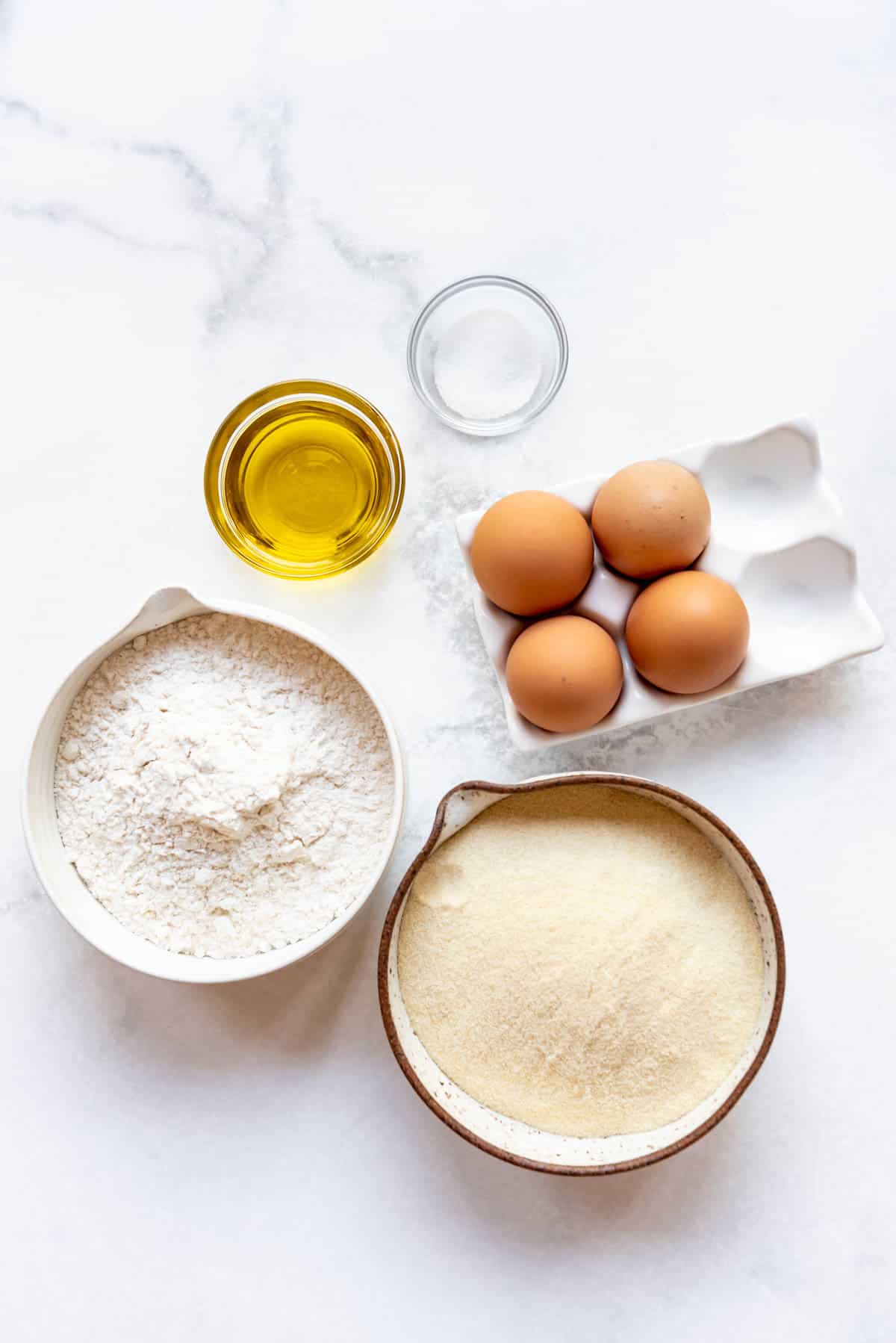
How to Make Homemade Pasta Dough
Making pasta dough from scratch is as simple as making a well in a pile of flour, adding your eggs, and kneading until the dough is smooth.
- Make a well in your dry ingredients. Mix the semolina flour, all-purpose flour, and salt together, either in a bowl on directly on a clean surface where you plan to mix the dough. Make a pile of the flour and use your fingers to create a well in the center of the flour. This will hold in and contain the eggs so they don’t run all over, although it’s okay if they spill out a little bit.
- Add eggs and olive oil. Crack the eggs right into the center of the well. Add in the olive oil and start mixing with a fork, breaking up the yolks and whites and moving in a circular motion. The flour will gradually get incorporated with the eggs until a dough starts to come together. This can all be done in a bowl if you are worried about runny eggs spilling out and running around your counter.
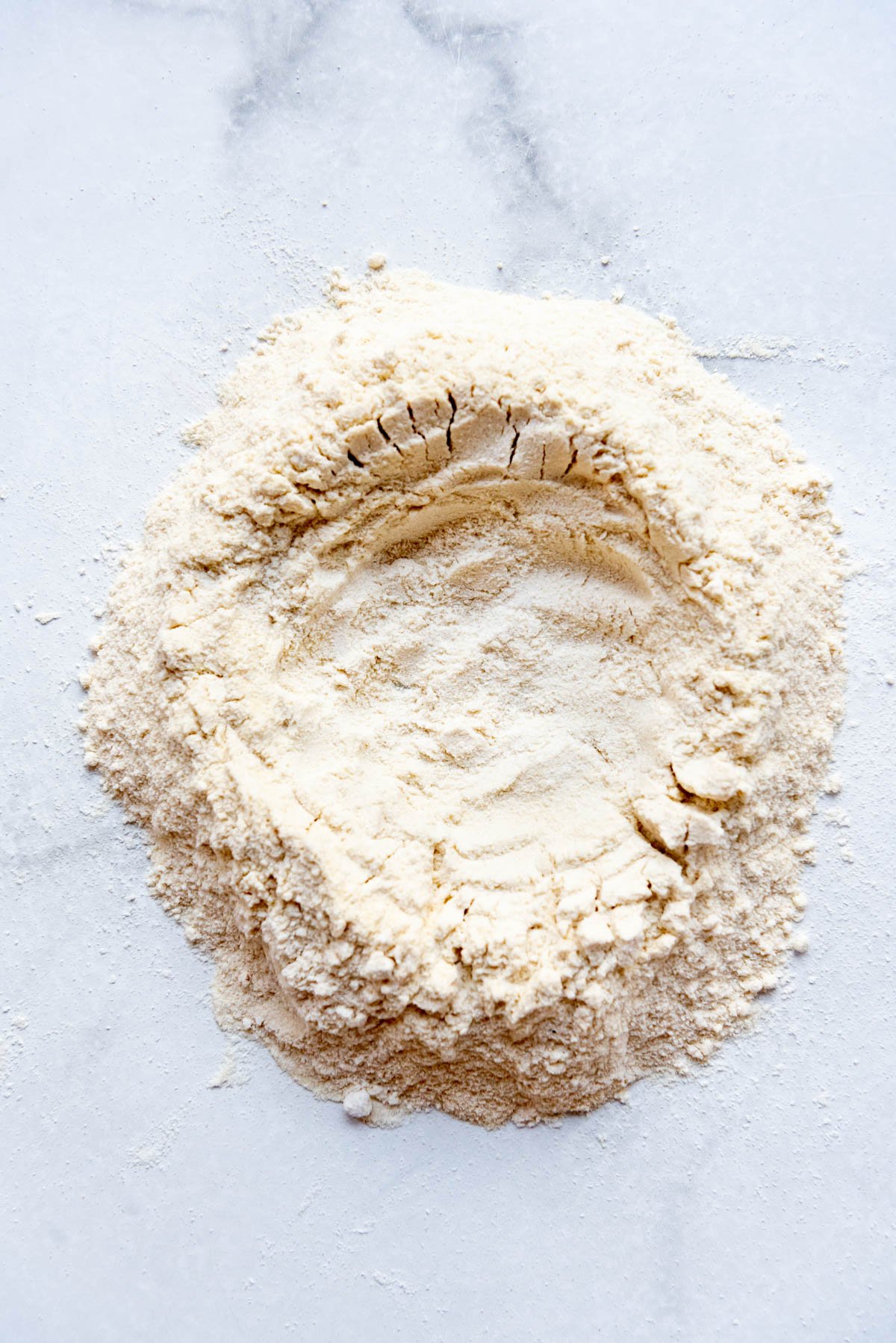
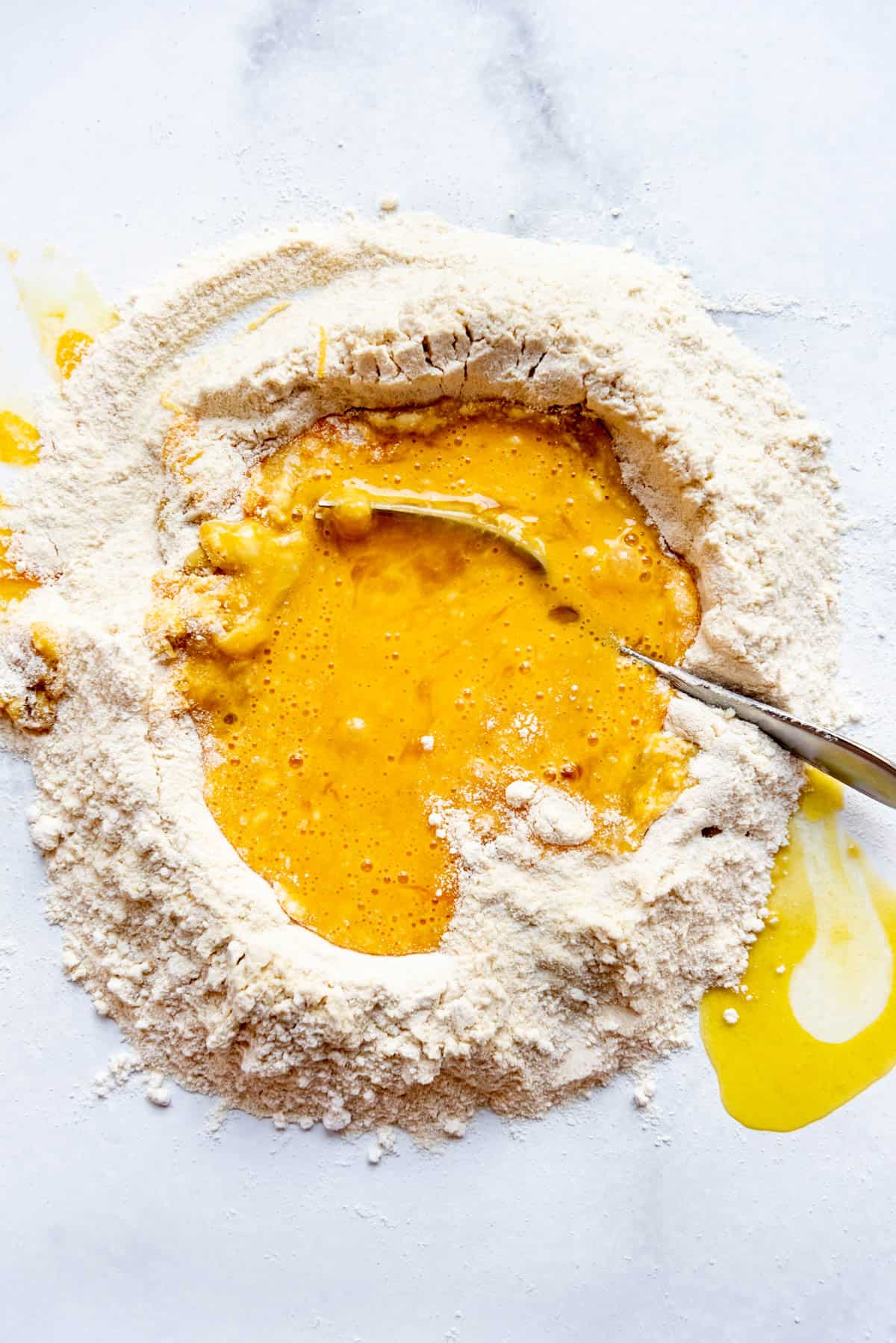
- Knead for 7 to 10 minutes. Use the heels of your hands to knead the pasta dough until it is evenly moistened and holding together well. If it’s feeling too dry, add a little water, 1-2 tablespoons at a time. If the dough is feeling too wet, sprinkle a little additional flour over the dough and knead it in. The dough ball should be smooth, not shaggy and the texture should be somewhat silky. You shouldn’t see streaks of egg or flour that haven’t been mixed together at this point.
- Let the dough rest. When you are done kneading the pasta, cover the ball of dough with plastic wrap or a damp kitchen towel and leave the pasta alone for 30 minutes so the gluten can relax before rolling it out.
The whole process of kneading the dough should take about 7 minutes of consistent kneading by hand in order to build the gluten strands that will withstand the rolling and stretching required for shaping the pasta into noodles or other shapes without breaking.
Historically, pasta dough is made by hand and you learn over the time the way the pasta dough should feel and whether it is too wet or too dry or it just needs more kneading. You can knead your pasta dough in a machine with a dough hook attachment for the initial mixing and kneading, but I highly recommend finishing most of the kneading with your hands so you learn the feel of good pasta dough.

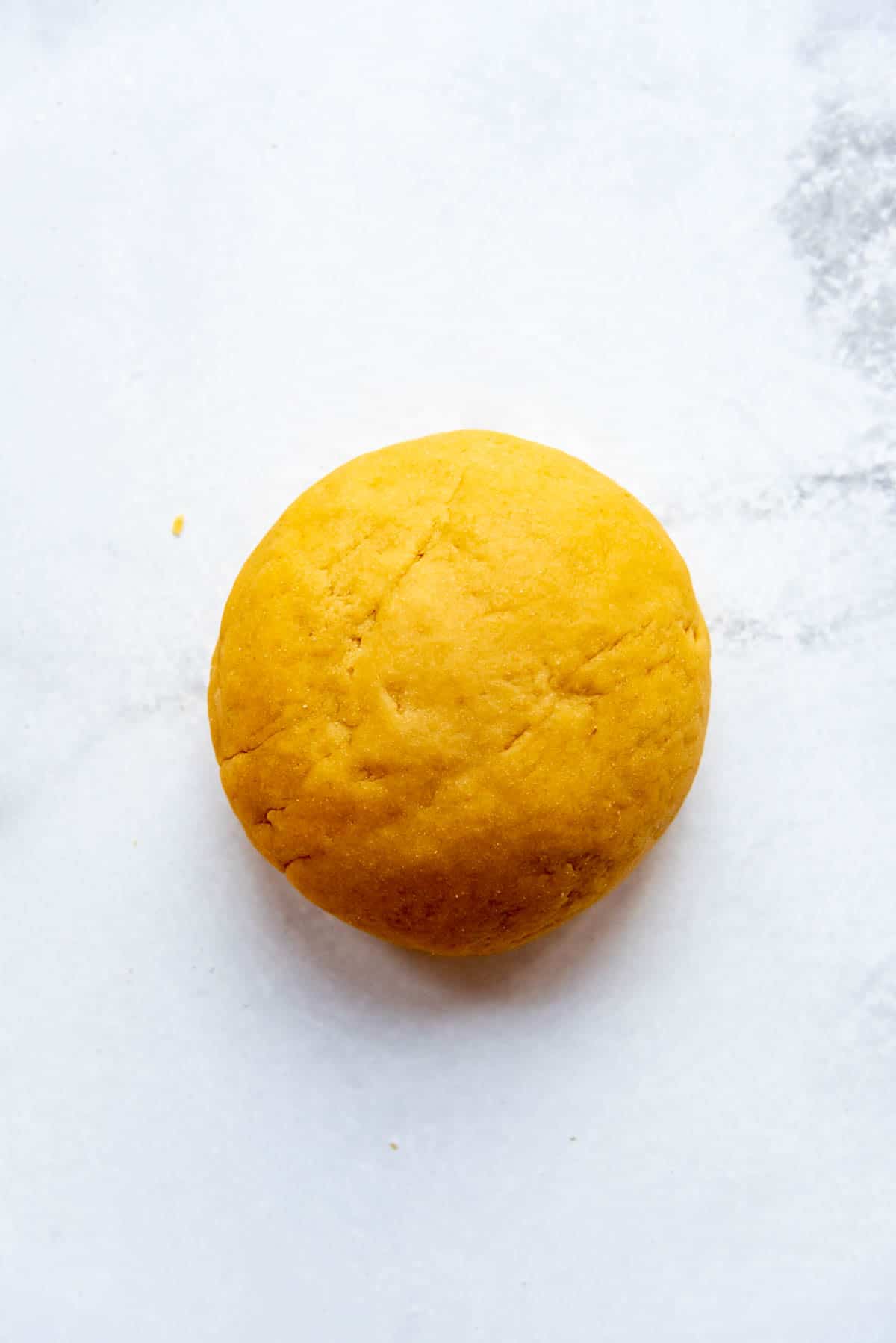
- Divide dough into thirds. Press each section of the fresh pasta dough flat-ish between your hands to make it easier to pass through your pasta press and dust it on both sides with a little bit of flour so it doesn’t stick. Only work with one section of the pasta dough at a time and keep the rest of the dough covered with a piece of plastic wrap or a damp cloth.

- Roll the dough the the widest setting on the pasta press. Start with your pasta roller attachment set to its widest setting. On my KitchenAid attachment, that is setting 1. If you are using a manual pasta press, you will need to crank the pasta roller by hand, but either way, it should grab the dough and pull it through the machine for you. You shouldn’t pull or stretch the pasta dough or it could tear.
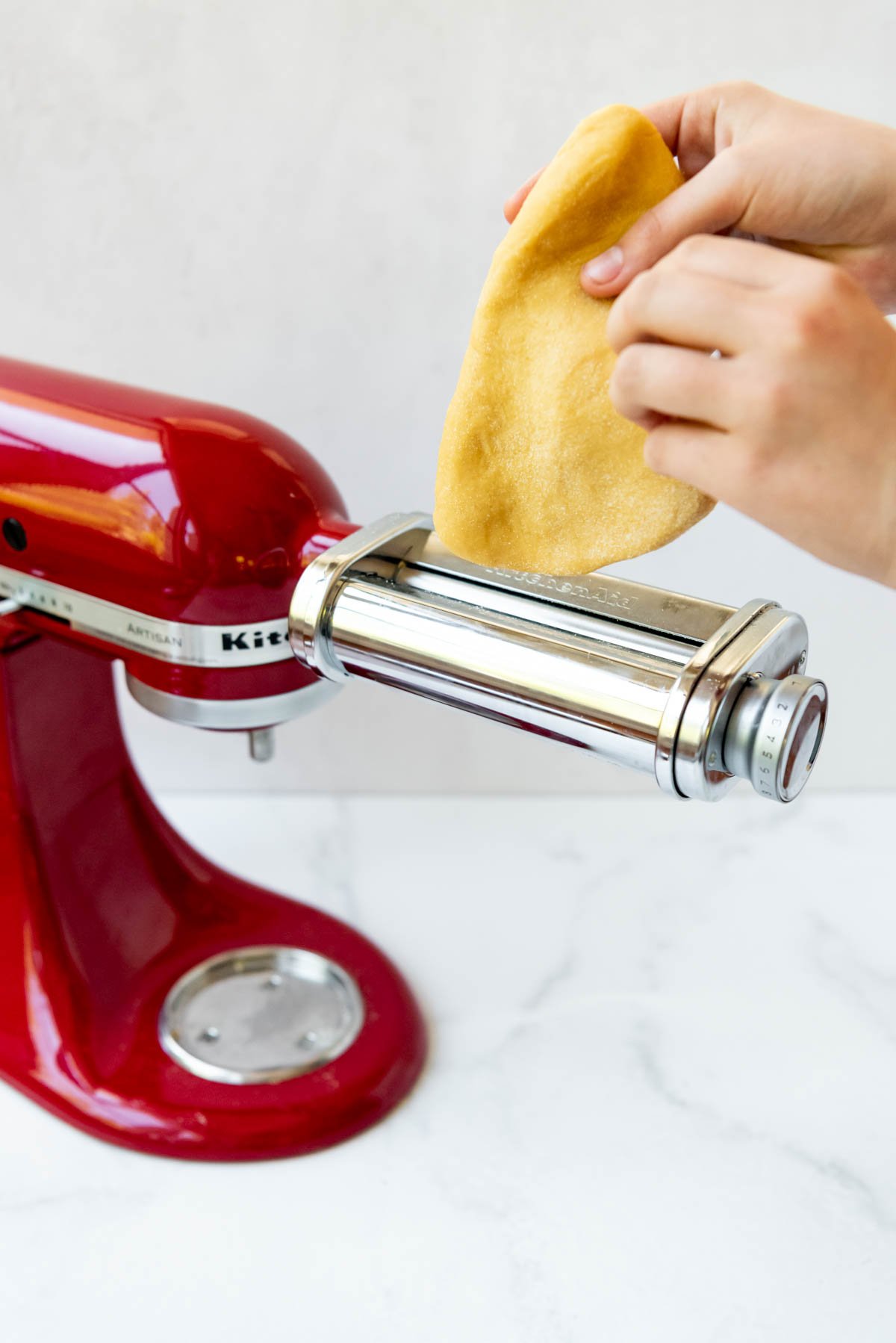
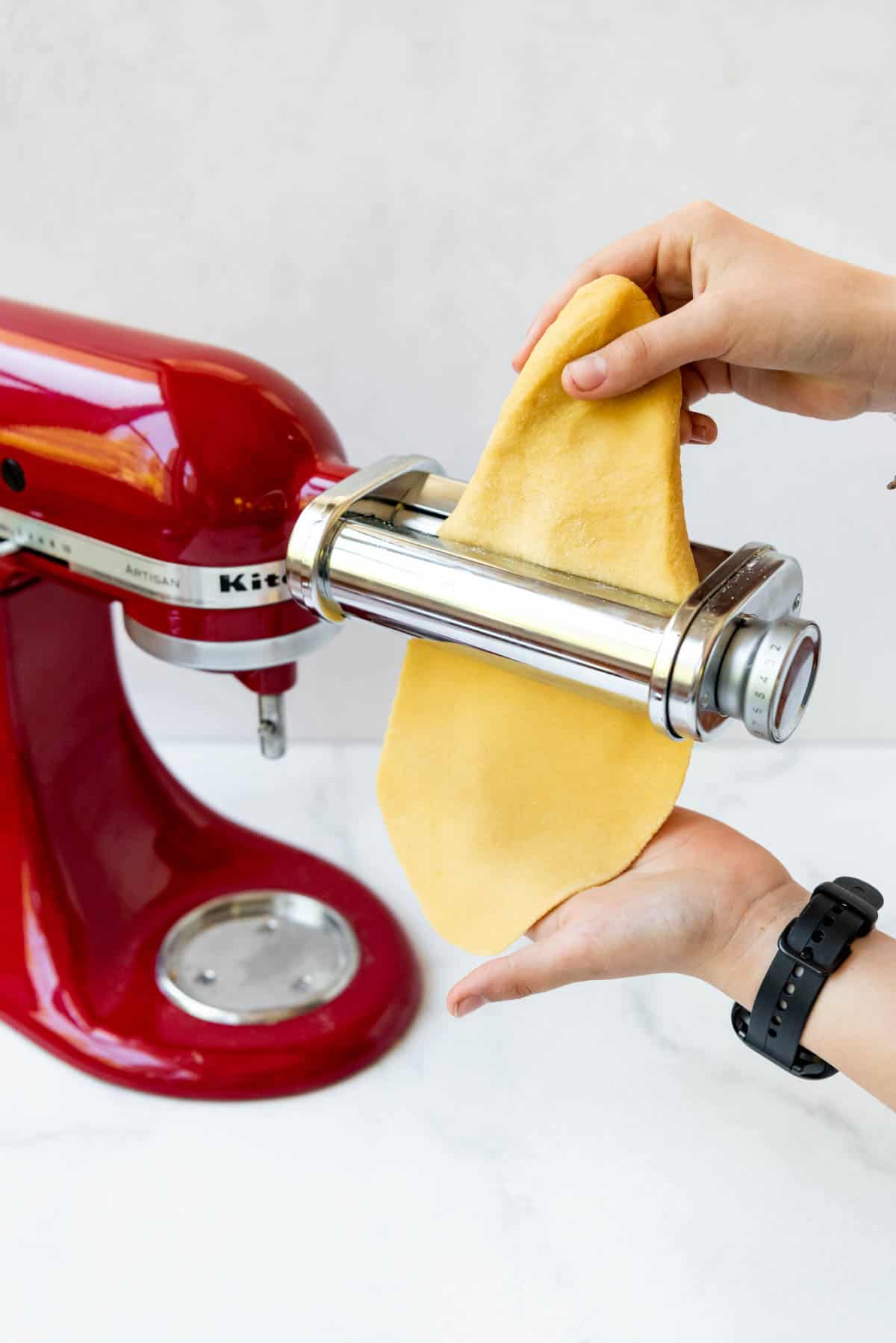
- Fold the dough into thirds and repeat. You will want to run your dough through the rollers of the pasta machine multiple times on the widest setting, folding it and re-running it 3-4 times. This will help create a clean rectangular shape to your pasta sheet while strengthening the dough at the same time. Continue to dust the dough lightly with a little flour between passes, if needed.
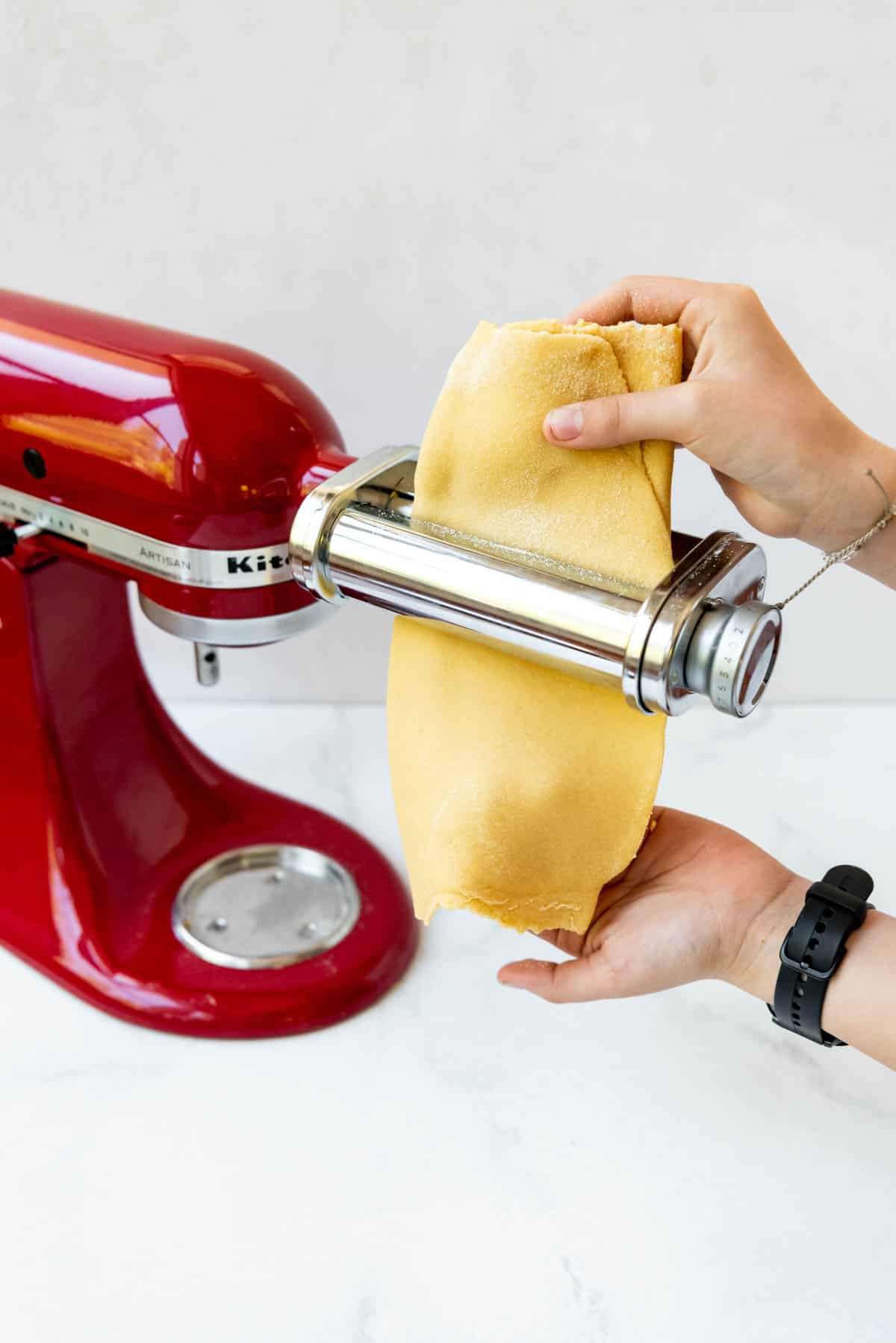
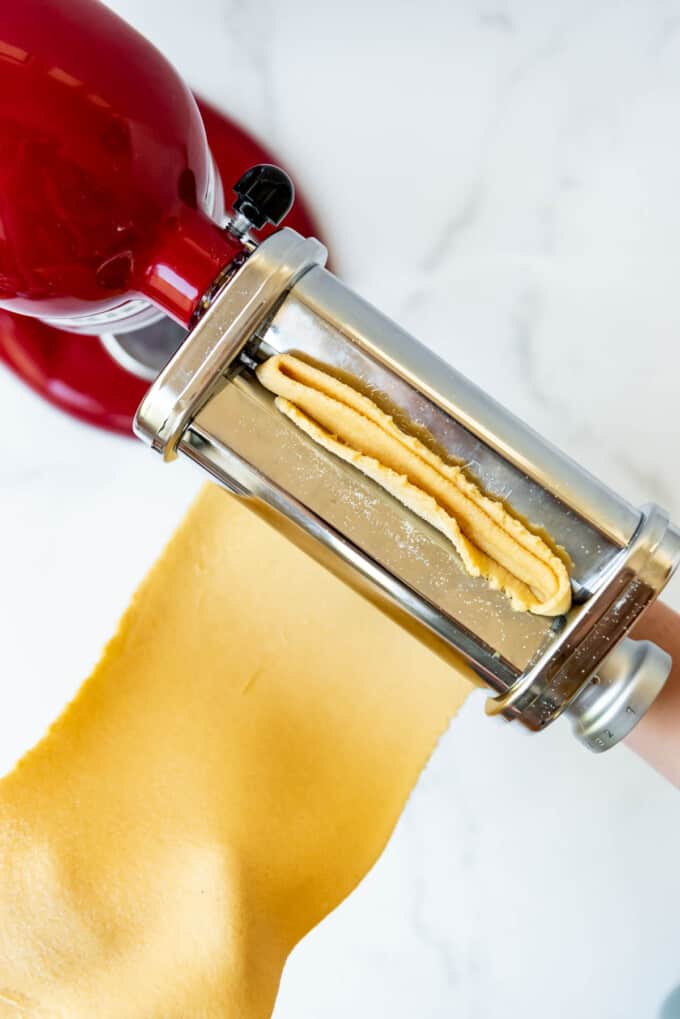
- Decrease the width of the rollers with successive passes. Continue to run the sheet of pasta through the pasta rollers, narrowing them with each pass, until you reach your desired thickness. Do not fold the pasta dough on itself between passes like you did on the widest setting or you will need to go back to a wider setting and repeat the previous steps down to thin out the dough. By the second or third pass, you may find it easiest to cut the pasta sheet in half or thirds (about the length of the noodles you want to achieve) so it is easier to work with.
For noodles like linguine, fettuccine, or pappardelle, you should stop around 3 settings from the thinnest setting. On my KitchenAid attachment, setting 5 would be where I would stop.
For pasta sheets for lasagna or ravioli, stop at the 2-3 settings from the thinnest setting. On my KitchenAid attachment, that would be setting 6 or 7. I find I don’t use setting 8 because at the point the dough is so thin it’s hard to work with without it tearing.
- Cut into noodles. Once the pasta has been rolled thin enough, switch to the cuttring attachment that will give you your desired noodle size. Lightly dust the pasta sheet with flour one more time. I like to keep a baking sheet nearby with a thin layer of flour that I dip the pasta sheet in. Feed the sheet of fresh pasta into the cutter. Gently transfer the freshly cut pasta to a clean baking sheet sprinkled with more semolina flour. I like to dust each strand of pasta with semolina to prevent them from sticking together.
- Twirl into nests. I like to twirl the freshly cut pasta into portion-sized nests. You can freeze them like this and easily pull out only as much fresh pasta as you would like. Another option is to hang the individual strands of pasta from a pasta drying rack to allow them to dry out.
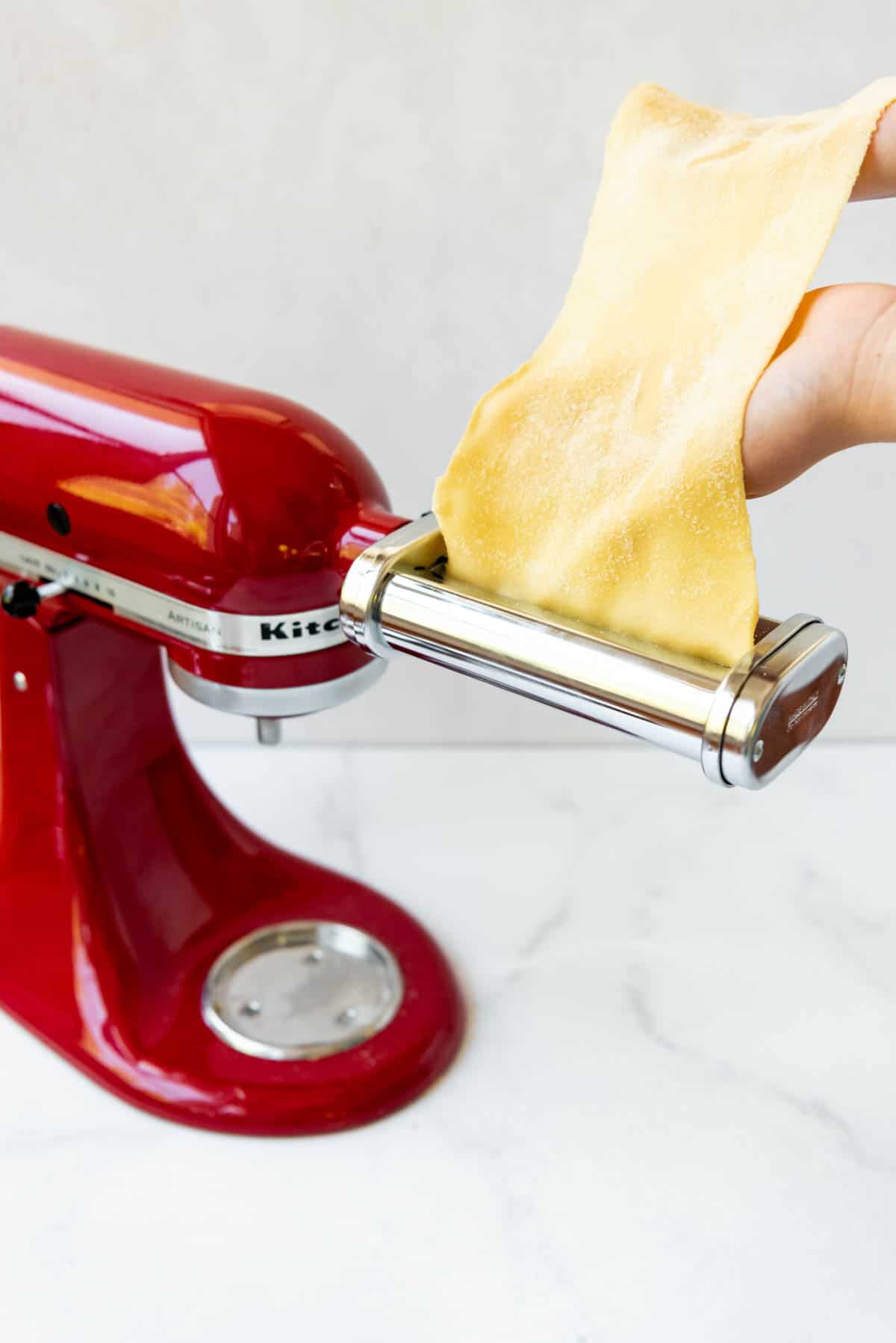

Spinach Pasta
The recipe below is for a basic pasta dough, but to make spinach pasta, all you have to do it blend cooked, drained spinach or frozen spinach that has been thawed and squeezed out with the eggs and olive oil before adding this mixture to the flour. Then you proceed as normal!
I did find that I needed to use a little extra flour because the dough was slightly stickier, but otherwise everything is the same.
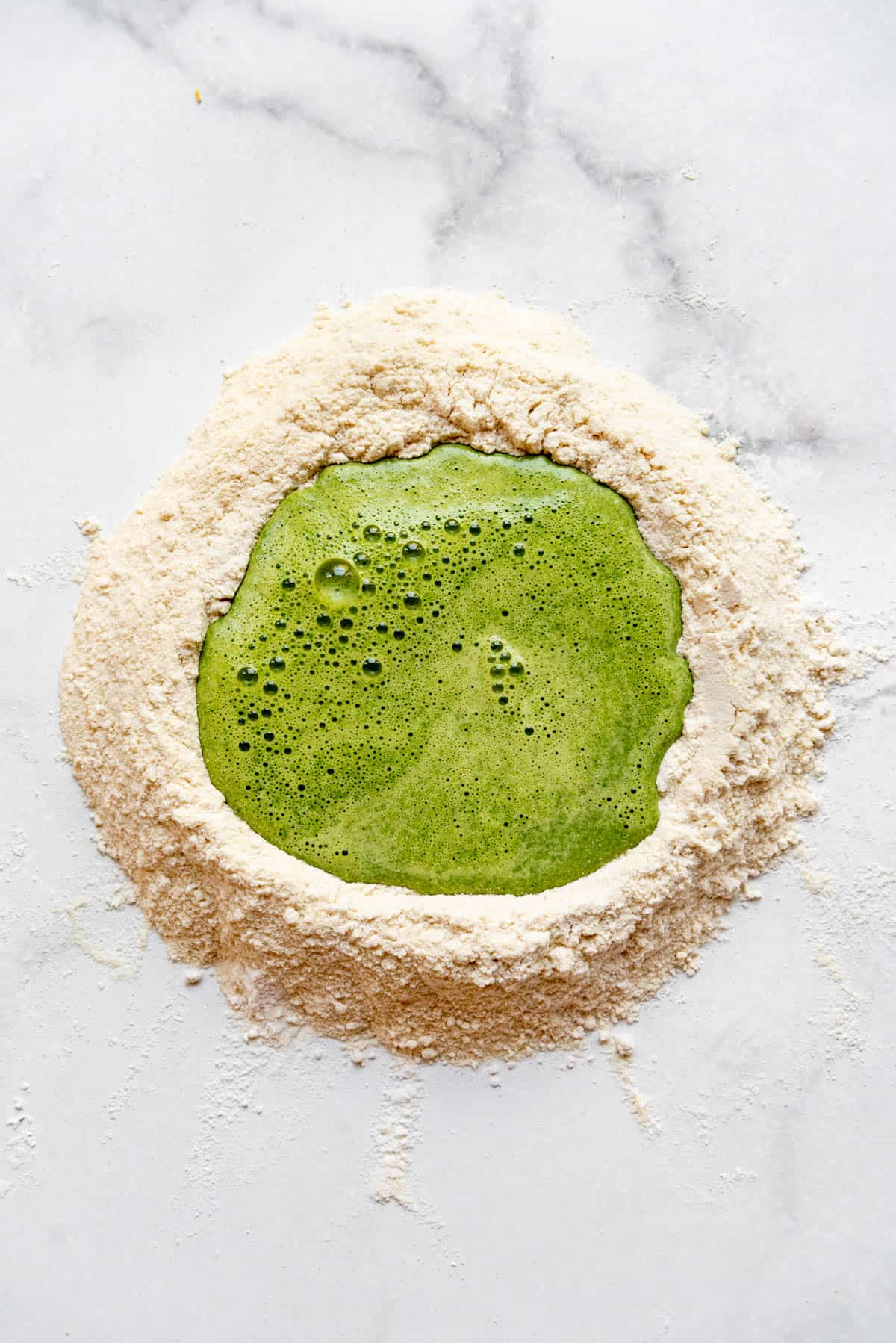
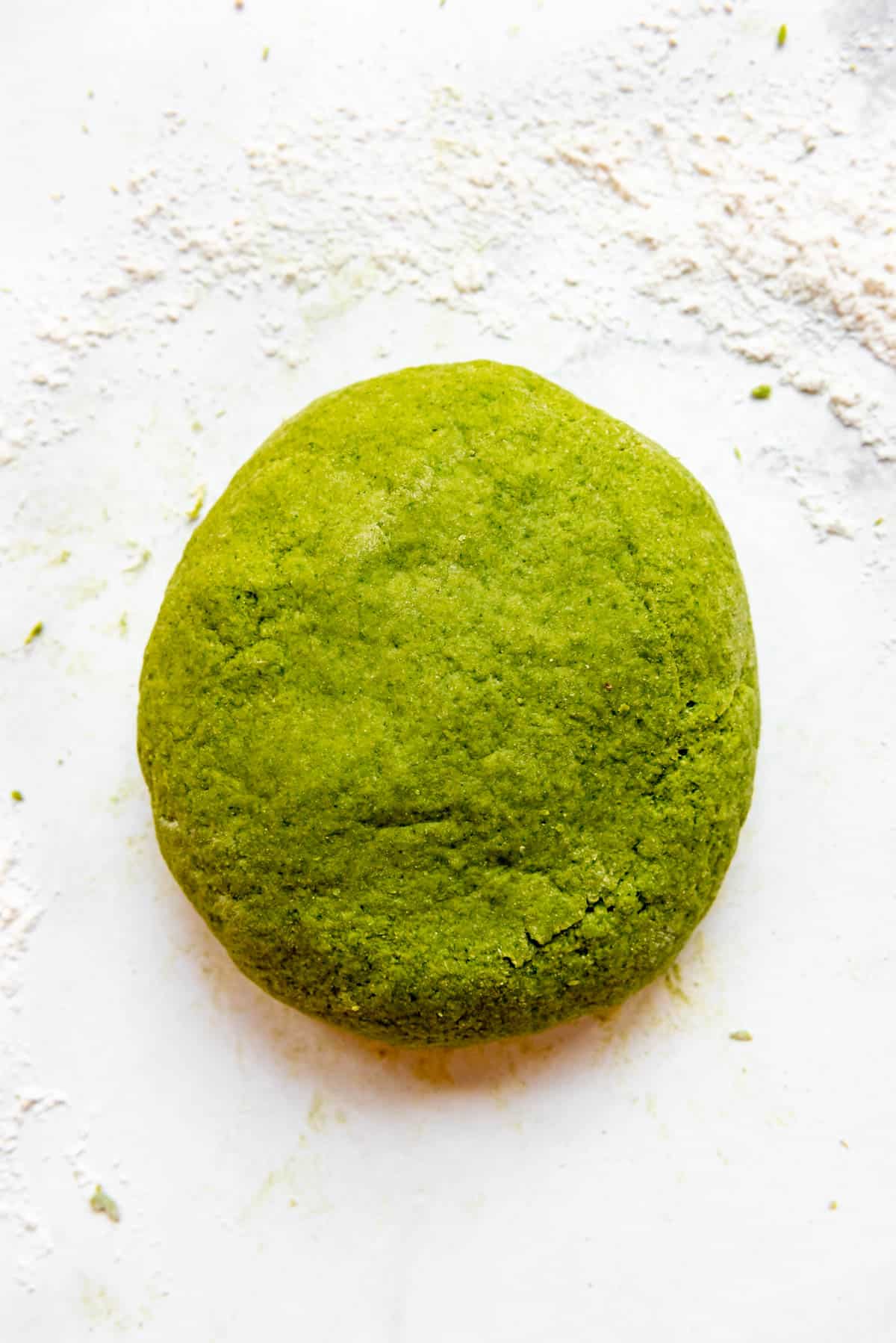
How to Make Fresh Ribbon Pasta
The easiest way is with a pasta roller that can either be purchased stand-alone or as an attachment to a KitchenAid stand mixer. It’s a bit pricy, but if you love fresh pasta you will find that you use it all the time. It can also be used for things like rolling out your cannoli dough if you want to try making homemade cannoli.
I think it’s a great investment or it makes a great gift for the cook in your life (I actually got mine for Christmas a few years ago).
I have also made fresh pasta with a friend’s counter top roller and they work just as well. You can find either manual crank rollers or electric powered rollers. Just choose one that works best for you!
How to Make Shaped Pasta
If you are making shaped pasta, it’s very easy if you have a pasta press attachment or stand-alone pasta extruder. You simply add balls of pasta dough to the machine with a die at the end. As the dough is pressed through the die, various shapes are cut.


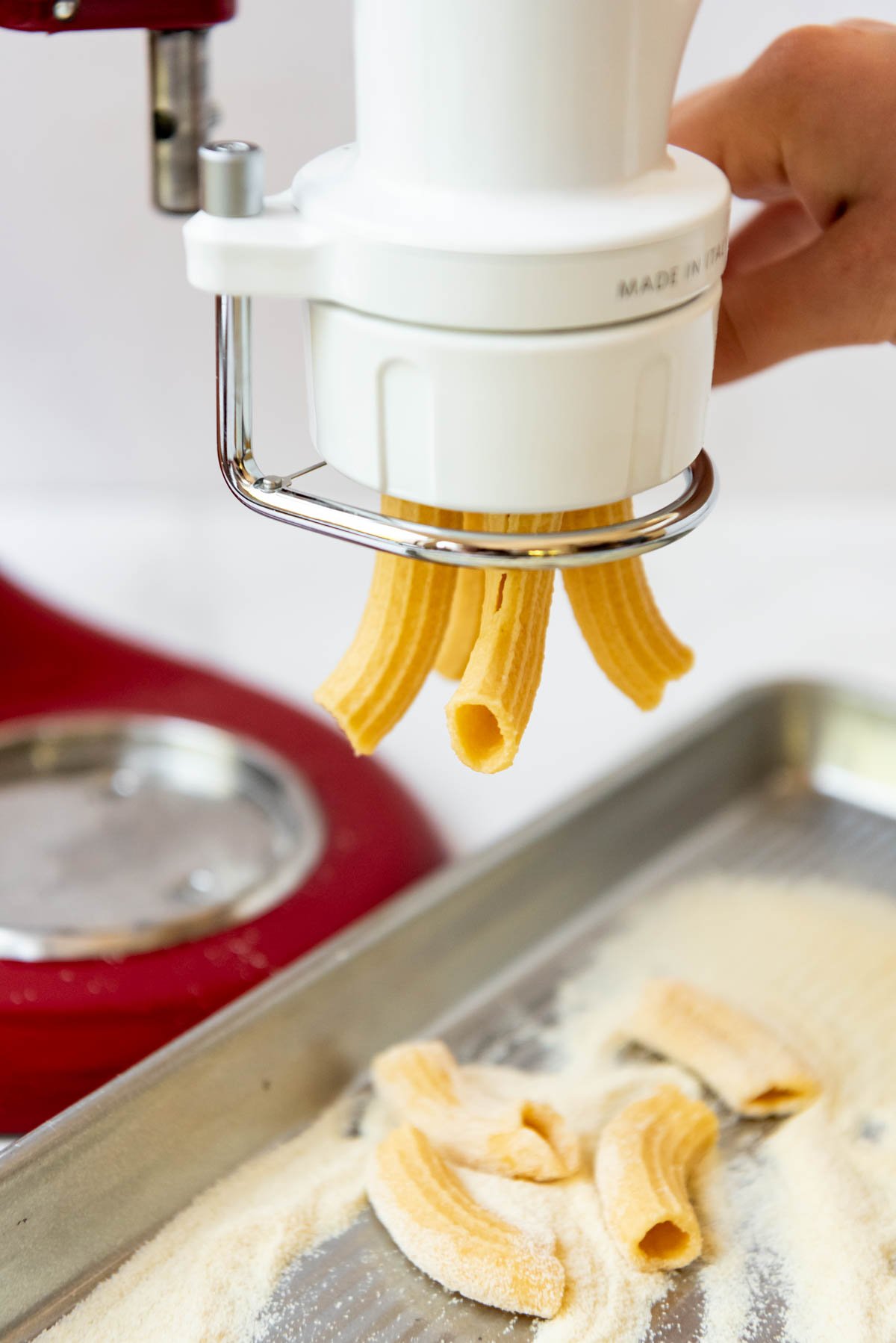
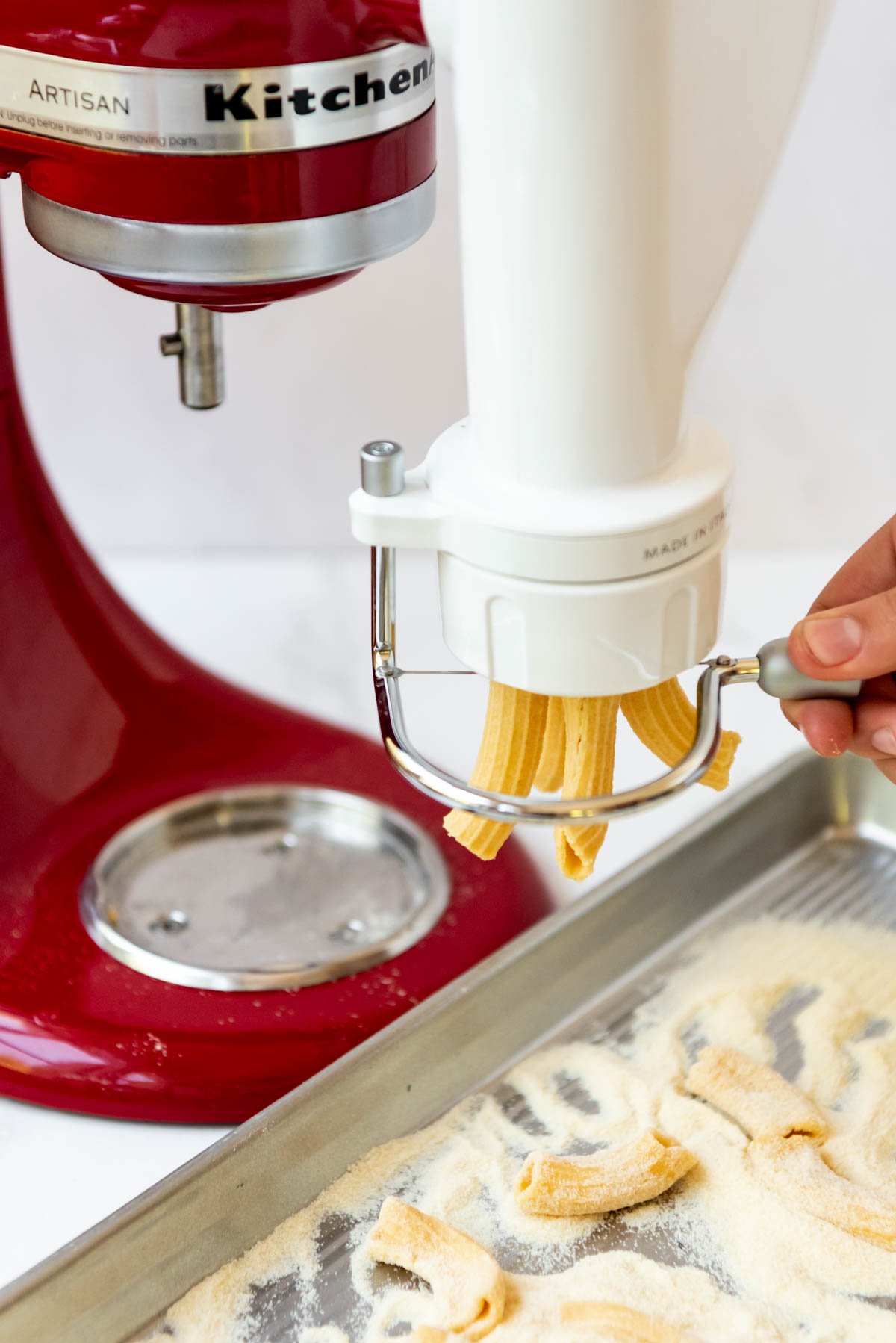
Just as with ribbon pasta, shaped pasta should be tossed in additional semolina flour soon after cutting so they don’t stick to each other. I actually found it worked best to sort of throw a little flour on the pasta shapes as they were coming out of the machine because sometimes when I cut them off using the built in wire cutter they would stick and clump together otherwise.
You can see in the picture below of the spinach bucatini how towards the top of the pasta strands where they were just extruded they aren’t dusted with semolina yet. It can be a bit messy with flour everywhere, but I just keep a clean baking sheet under the extruder and it contains most of the mess.
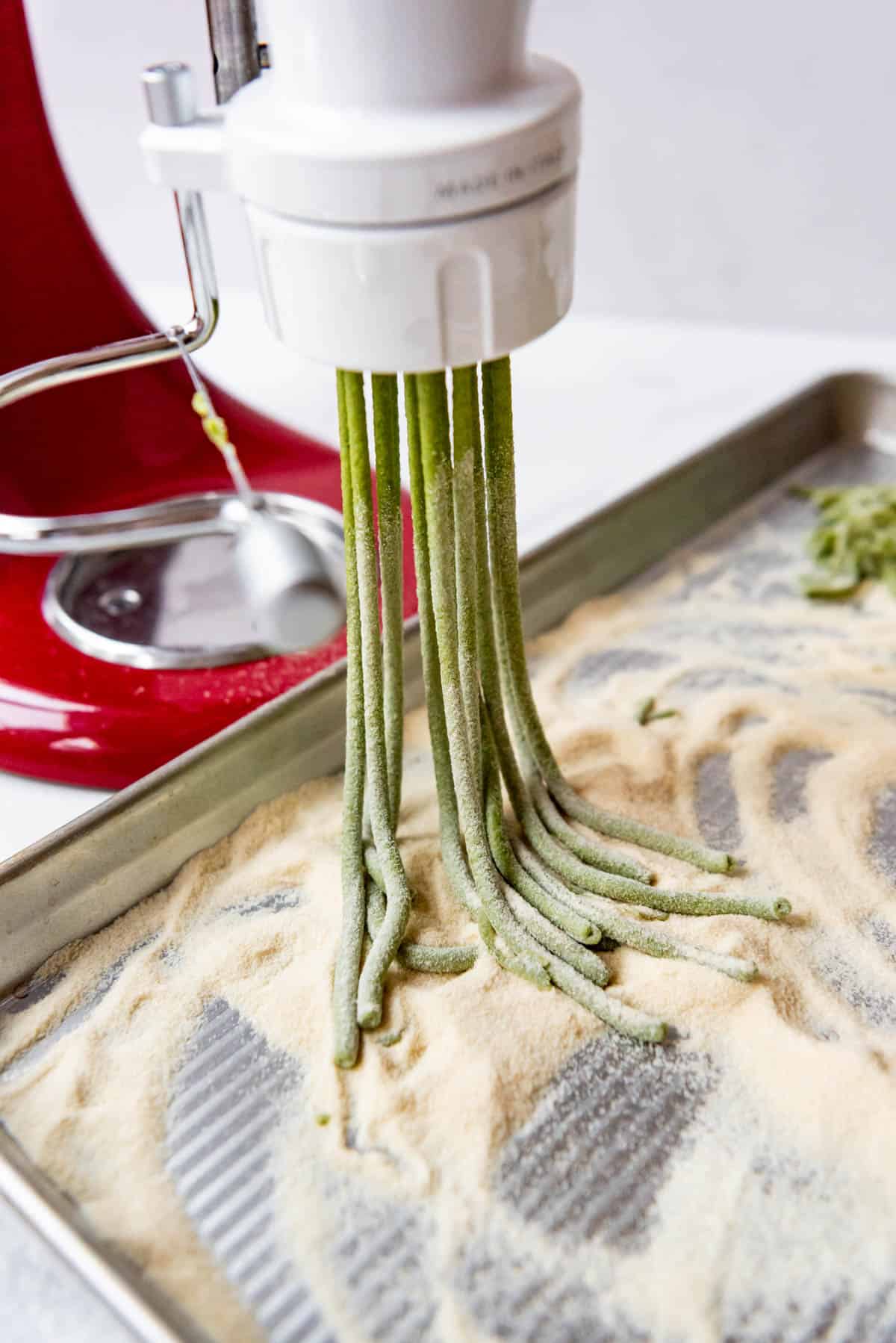
There are also many specialty pasta shapes that can be made the old-fashioned way, entirely by hand without any machine at all!
How to Make Pasta Without a Machine
Use a rolling pin (affiliate link) to roll out the pasta dough and cut it into your desired shapes. You can purchase all kinds of fancy pasta cutters or just use a pizza cutter or sharp knives.
Some pasta shapes that you can make by hand include orecchiette, farfalle,
There are some great video tutorials on YouTube for many different types of pasta shapes, so I would recommend searching there.
How to Make Pasta With a Machine
If you have a sturdy stand mixer like a KitchenAid, you can start by mixing the flour and eggs with the dough hook on the lowest setting until the dough comes together. At that point I would still recommend turning the dough out onto a clean counter and kneading by hand.
There are really great KitchenAid attachments that can be used for making homemade pasta in all kinds of shapes.
How to Store Homemade Pasta
Once your pasta is done, you can either cook it immediately or store it if you are making it a little bit ahead.
If you are planning to cook it within 24 hours, you can just store the fresh pasta in an airtight container in the fridge. If you know you will be waiting longer than that, you might want to freeze the pasta, then portion it into airtight containers and store in the freezer for up to 6 months.
There is no need to thaw frozen pasta before cooking it. Just add it to the boiling water and cool like normal.
How to Cook Homemade Pasta
Fresh pasta cooks much more quickly than dried pasta. While most dried pasta takes 7 to 9 minutes to reach al dente, fresh pasta only takes around 3 to 5 minutes to cook to al dente perfection where it is tender but still has a firmness to it.
If you are making fresh pasta to go with another dish or sauce, it’s best to wait until everything else is done before cooking and adding the fresh pasta.

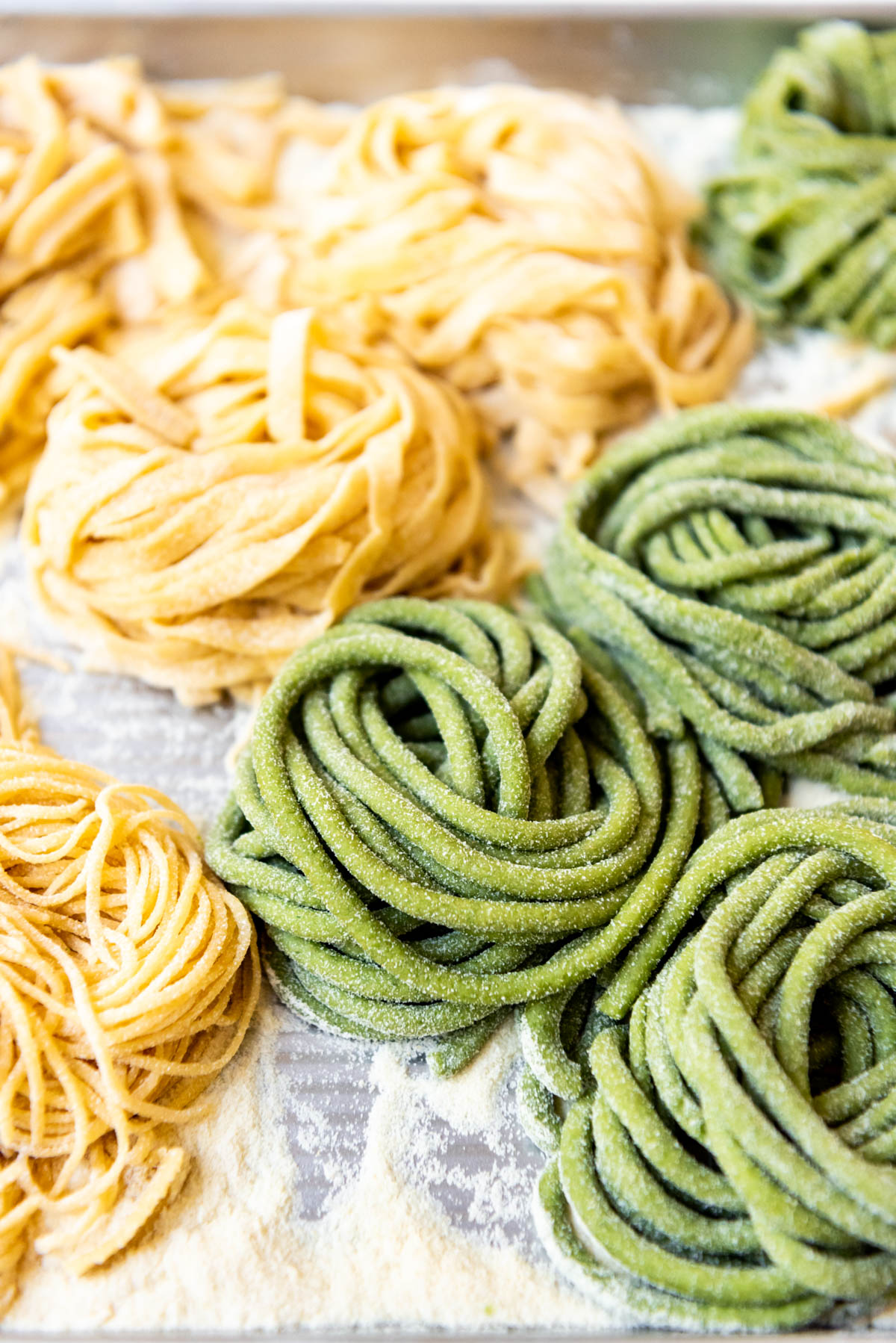
Recipe FAQ’s
When it comes to really good homemade pasta, my top pick is semolina flour. A good runner up is 00 flour. But before you throw in the towel because you don’t have either of those types of flour on hand, you can absolutely make homemade pasta with whole wheat flour, bread flour, and even all-purpose flour. Each will yield a slightly different result, but they all work in terms of getting fresh pasta on your table.
The main difference for me is texture. Pasta with made all-purpose flour tends to be denser and chewier, while pasta made with semolina flour is lighter and more toothsome.
If your pasta is rubbery or mushy, it’s likely that it got overcooked. Be sure to cook homemade pasta no longer than 3-5 minutes to avoid this pitfall.
Yes, to make eggless fresh pasta, just omit the eggs called for in the recipe below and replace them with about 1 to 1 ¼ cups room temperature water. Pasta dough made with eggs is more typical of Northern Italy (often times with a higher ratio of egg yolks rather than the whole eggs that I’m using in my recipe below), while 2-ingredient pasta dough made from just semolina and water is more typical of parts of Southern Italy. Each region has its own pasta shapes and type of dough that is popular and I’m not claiming that my recipe is authentic in any way. It’s just what I have found easiest to work with!

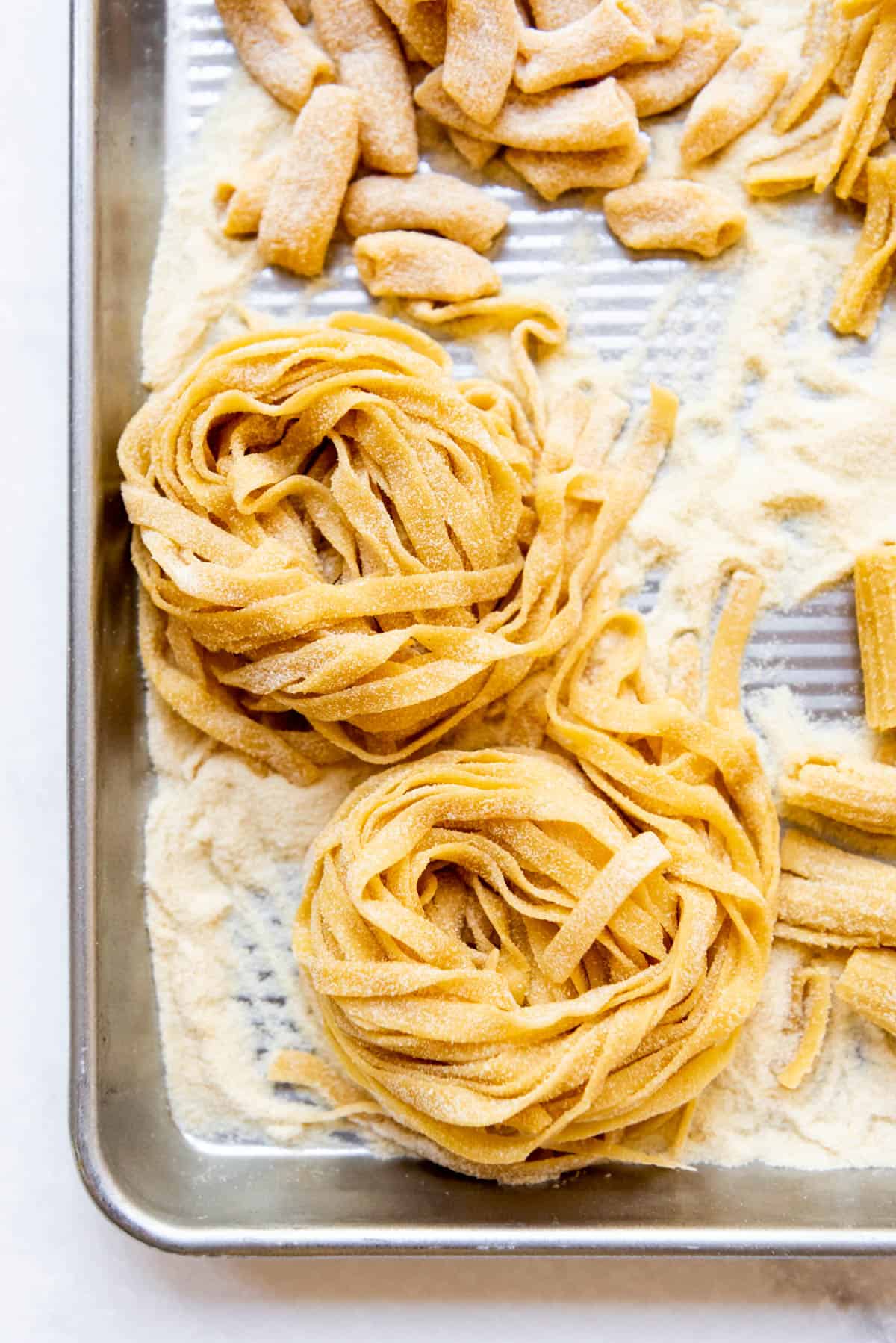
Tips for Success
- Use fresh eggs. Because fresh pasta uses so few ingredients, you will definitely notice a difference in the quality of the ingredients you use. Fresh, whole eggs will give a delicious flavor to the pasta that will make it stand out from store-bought pasta.
- Invest in the tools to make it easier and more enjoyable. Technically, you can make homemade noodles with just a rolling pin (affiliate link) on a floured surface, but it’s hard work to roll out the pasta dough thin enough. Trust me, I’ve tried. I recommend getting a KitchenAid pasta roller attachment for your KitchenAid mixer if you have one, or investing in a manual pasta cutter that attaches to your counter and can be cranked by hand.
- Get the family involved! Kids love helping knead the pasta dough and run it through the pasta rollers or catch the pasta as it comes out of the machine. There is a lot of great hands-on fun to be had making homemade pasta!
How to Store Fresh Pasta
Although you can cook with your fresh pasta right away, you can also store it in an airtight container in the fridge for 24 hours. Any longer than that and I would recommend freezing your pasta. You can also just make the pasta dough ahead and store it in the fridge overnight, then let it come to room temperature the next day before rolling and cutting.
To freeze fresh pasta, place your pasta nests (for ribbon pasta) on a baking sheet lined with parchment paper with a little space between them. Cover with plastic wrap and freeze for 2 hours. At this point, you can transfer the pasta nests to a freezer-safe ziploc bag or airtight container for longer storage of up to 3 months.

Our Favorite Pasta Recipes to Use With Homemade Pasta
Did you make this recipe?
Let me know what you thought with a comment and rating below. You can also take a picture and tag me on Instagram @houseofnasheats or share it on the Pinterest pin so I can see.
Homemade Pasta Recipe
Ingredients
- 1 1/2 cups semolina flour (270g)
- 1 1/2 cups all-purpose flour (188g)
- 4 large eggs, room temperature
- 2 Tablespoons olive oil
- 1 teaspoon salt
- 1/4 cup room temperature water, as needed to add to the dough if too dry
Instructions
- Mix together semolina flour, all-purpose flour, and salt together. Make a well with the semolina flour and all-purpose flour on a clean surface. Add eggs and olive oil. Mix together until a ball forms. If the dough feels too wet, add a little extra semolina. If it feels too dry, add a little extra water.1 ½ cups semolina flour, 1 ½ cups all-purpose flour, 4 large eggs,, 2 Tablespoons olive oil, 1 teaspoon salt, ¼ cup room temperature water,
- Knead for 7-10 minutes until smooth. Cover with plastic wrap and let the dough rest for 30 minutes.
- If you don't have a pasta press, roll out the pasta dough on a lightly floured surface to your desired thickness. Cut out using a pizza cutter or sharp knife into thin pasta noodles. For fettuccine or pappardelle, fold the pasta over itself a few times so you have a few layers of thickness for easier cutting. After you cut them, you can gently shake out the folds to separate the individual noodles.
- If you have a pasta press, divide the dough into thirds and lightly dust with flour, if needed. Run each third through the pasta press on the widest thickness. Fold it in half, then run it through again, turning it a quarter turn to run through the other direction. Repeat 3 to 4 more times, folding and rotating the dough to form a clean rectangle. Continue running the dough through the pasta press, decreasing the thickness each time.
- If using a pasta cutting attachment: Dip the pasta sheet in semolina and run it through the cutting attachment to make fettuccine or linguine. Coat the individual strands in semolina to prevent them from sticking and twirl into nests.
- If using a pasta extruder for shaped pasta: Roll walnut-sized balls of pasta dough and add them to the pasta extruder attachment one by one. The machine will press out pasta shapes for you!
- Dry on a drying rack, if desired, or refrigerate, freeze, or cook immediately. Store in an airtight container in the fridge for up to 24 hours or in the freezer for up to 3 months (see notes).
- Bring a large pot of salted water to a boil over medium-high heat. Cook the pasta for 3-5 minutes until al dente. If making lasagna, there is no need to boil the noodles first before assembling and baking the lasagna.
Notes
- Flour: You need 3 cups of total flour, although I like half semolina & half all-purpose flour best. You can make pasta exclusively with all semolina, all-purpose, 00, or whole wheat flour or any combination of the above. A combination of half all-purpose and half whole wheat is very good.
- Spinach Pasta: Replace 2 of the eggs with 10 ounces of frozen spinach that has been thawed and squeezed dry. Or 6 cups (3 ¾ ounces) baby spinach that is quickly cooked in a large pot of salted, boiling water for 30 seconds until wilted, then drained and plunged into an ice water bath. Drain well and squeeze dry. Blend eggs, olive oil, and spinach in a blender and blend until smooth before adding to the flour.
- Storage: Store the shaped pasta or unshaped pasta dough in the fridge for up to 24 hours in an airtight container. If you are storing the pasta dough, let it sit out at room temperature for 2-3 hours to come to room temperature before rolling out the next day.
- Freezing: Freeze the pasta in nests or a single layer on a baking sheet for 2 hours before transferring to a freezer-safe airtight container for longer storage up to 3 months. No need to thaw before cooking.
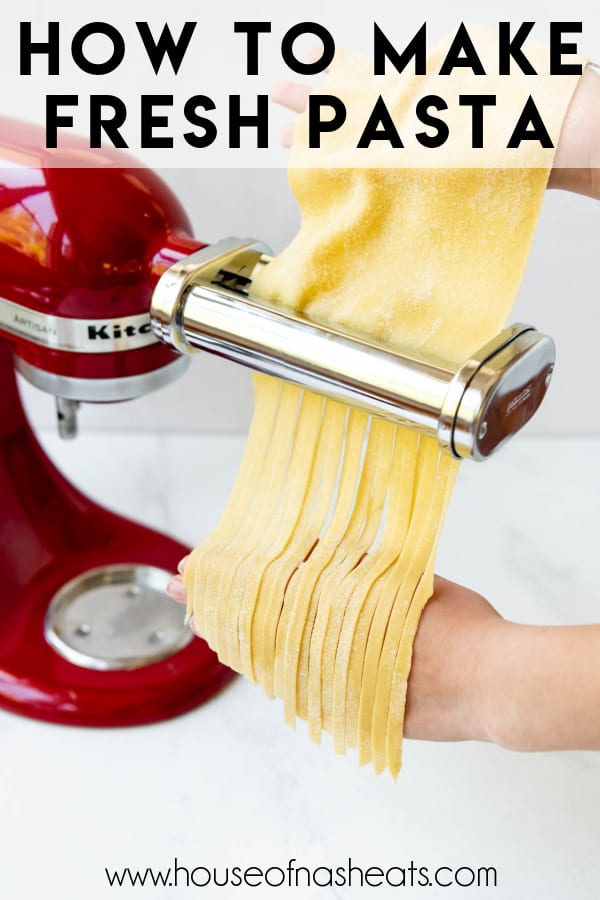
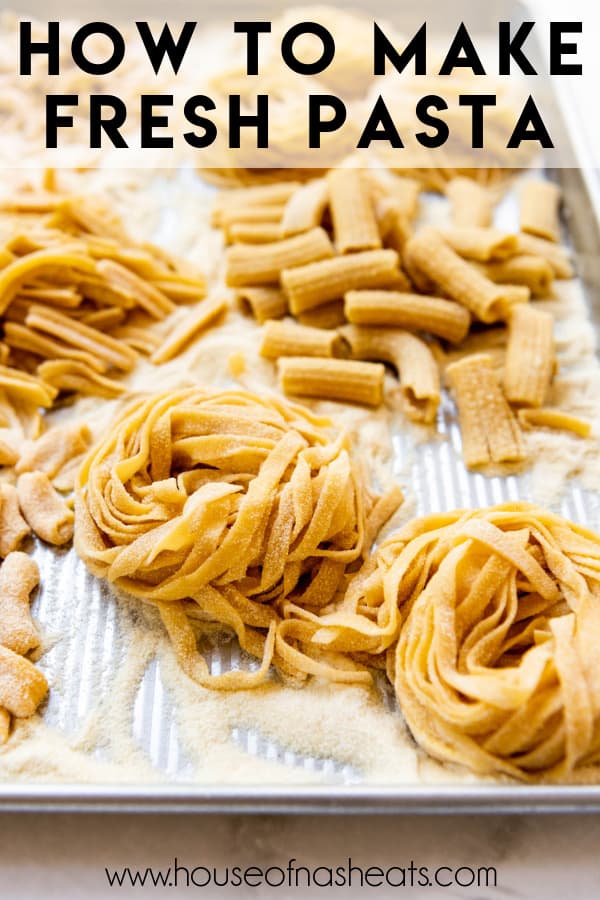
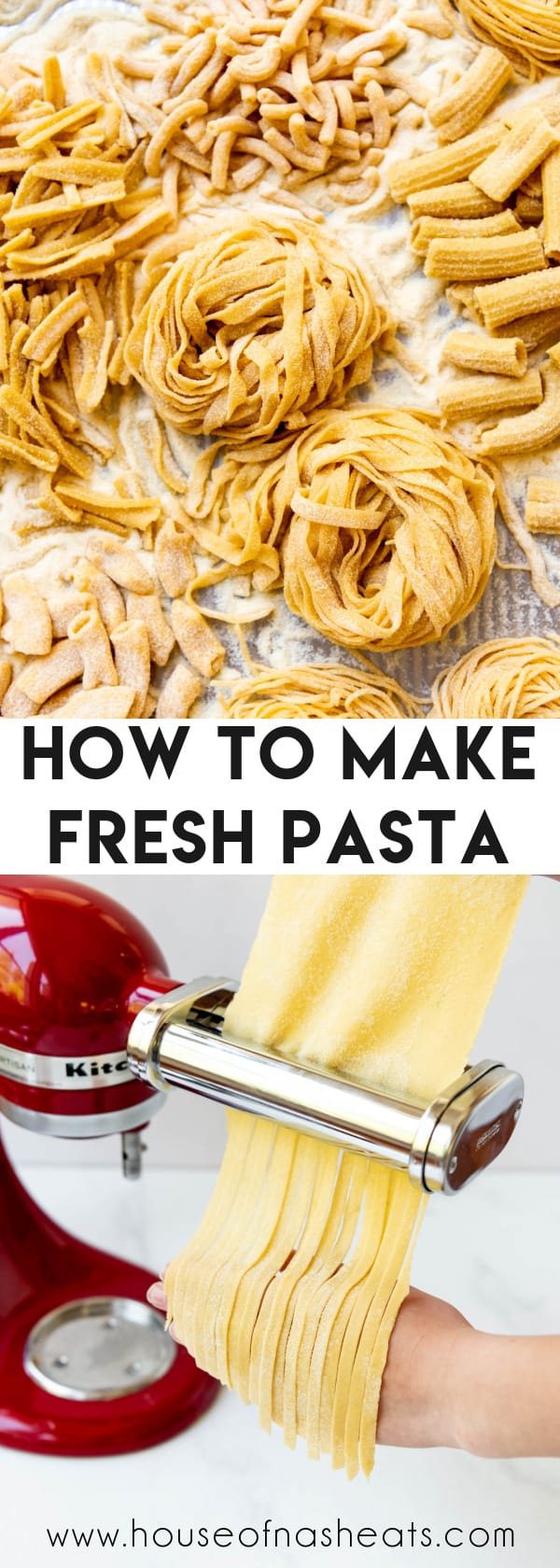
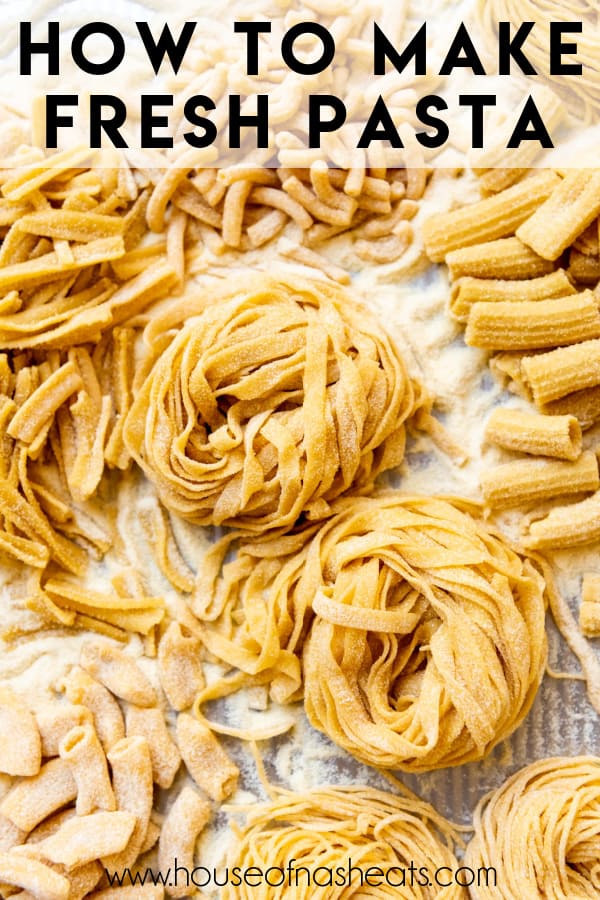
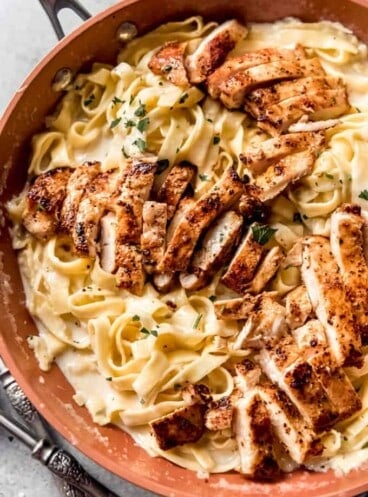
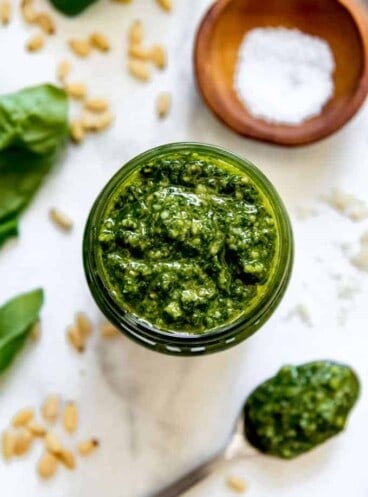
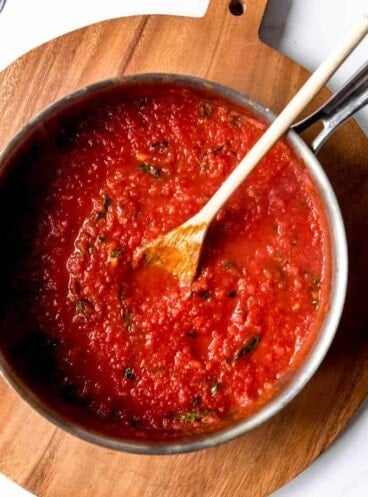
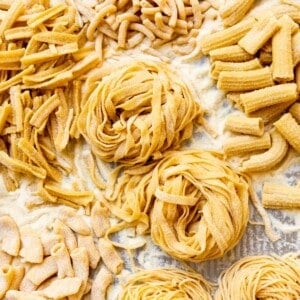
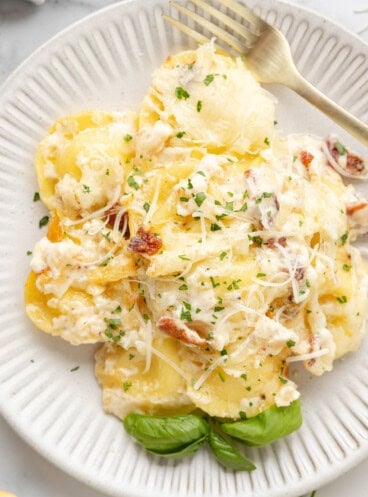

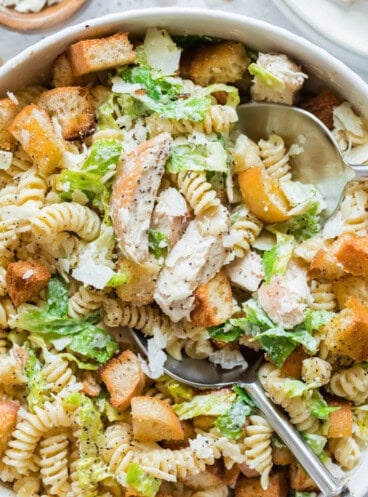
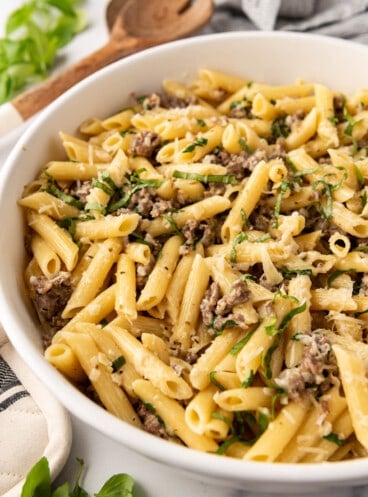

Where does the olive oil go in this recipe?
Hi! It is mixed in with the eggs. I will clarify that in the steps. Thank you!
Do you just add all of the flour at the beginning? I didn’t see when to add the regular flour or the salt. Also, how long does the drying take?
Mix the semolina flour, all-purpose flour, and salt together, either in a bowl on directly on a clean surface where you plan to mix the dough. The drying time can take 12-24 hours if you want the pasta to dry completely.
I make my pasta with this recipe using kitchen aid attachment. When I make fettuccine or spaghetti it’s great, but my smaller shaped noodles becomes very big after boiling. Do you have an advise for me what I’m doing wrong? Thank you
Spaghetti “noodles”? Please.
Figured I should come leave a review because I’ve used this as my go-to pasta recipe for about a year now. I use half semolina flour and half “00” flour. Nice and sturdy pasta.
That is great to hear! Thank you for using this recipe!